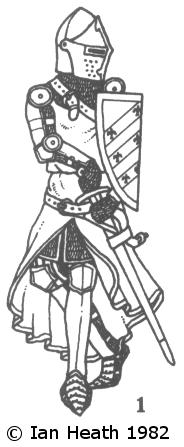 | SIR WILLIAM FITZRALPH c.1323An extract from Armies of the Middle Ages, Volume 1by Ian Heath The knight of the early-14th century differed from his 13th century forebears principally in his increased reliance on plate armour to protect his limbs. Sir William, for example, has his arms protected by rerebraces, vambraces and elbow-guards (couters or coudières), and his legs by greaves and knee-cops (grevières and genouillières), all of these being in fairly widespread use by the mid-1320s. They were all secured by straps, though the knee-cops were still often fixed directly onto the tubular quilted cuisses which protected the upper part of the leg. The circular plates protecting his armpits and the outsides of his elbows were called besagews, fastened in position by laces; those guarding the elbow soon (by c. 1360) came to be incorporated as heart-shaped extensions of the couter. In addition ailettes continued to be worn until c. 1350, though they were uncommon after 1330. His feet are protected by plate sabatons. These were usually articulated somewhat like a lobster’s tail, though the middle or toe portions were sometimes unjointed. Scale sabatons were also to be found (see next note), while in addition mail foot-armour remained in use throughout the 14th century. He wears prick spurs. The shield is still of the old heater-type, which remained in use until at least the early-15th century, occurring in ms. illustrations as late as the 1480s. It was most commonly made of wood and leather, the latter sometimes embossed with the bearer’s arms, which were otherwise painted on. The Black Prince’s shield, which is similarly of this type, is constructed of vertical strips of wood glued together and strengthened by a horizontal band of iron, covered by 2 layers of canvas glued together, with over it all a covering of leather with nails around the edges, the arms in this instance being moulded in relief in gesso douro. Some shields at least were faced with iron or steel. His sword is representative in general terms of those in use throughout the Hundred Years’ War period. It has a wide, 2-edged blade for cutting, tapering to a sharp point for thrusting. The blade was usually 30-36" in length, but could be as short as 28" (such short, stiff weapons being called ‘Bordeaux swords’ by Froissart), or as long as 40", in which case they usually had in addition a longer hilt to enable 2-handed use. It had a basically diamond cross-section, often with hollow-ground edges by the 15th century so as to lighten it. The grip was usually slightly swollen, with cross-guards which were either straight or drooped slightly towards the blade. Pommels were most often wheel-shaped, otherwise being pear-shaped or elongated. The scabbard was usually of leather, stamped with some sort of pattern or else mounted with gilt or metal decoration. Ivory is also recorded being used for scabbards. For much of the Hundred Years’ War period the sword scabbard was suspended from an ornate (often bejewelled or gilt) belt worn horizontally round the hips (see figures 5-7), though from the early-15th century onwards this was replaced by a narrow diagonal belt (figures 8, 10 and 11). A second sword was still sometimes slung from the front of the saddle as described under figure 14 in Armies of Feudal Europe, this often being a thrusting sword, which differed from the type described above in tapering from hilt to point. [Based on the brass of Sir William de Fitzralph] [The helmet is from the English Holkham Picture Bible of c. 1320 according to the next note.] Next: 2. SIR JOHN DE CREKE 1330, in Armies of the Middle Ages, volume 1 by Ian Heath |
Download 2 free e-books from Amazon Audible |
